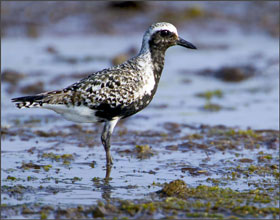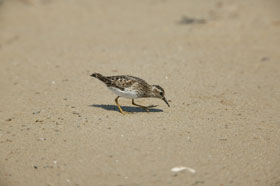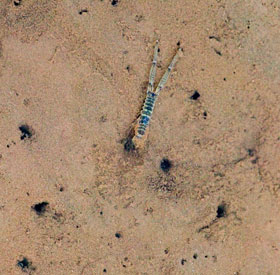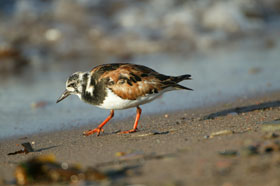Posted by bob on Mar 4, 2012in Articles
 There’s a jump to his step, a glint in his eye and a non-ending stream of superlatives coming from his heart. If it weren’t for the fact Pete Hicklin is vintage Acadian “Breyon” (according to the American Heritage dictionary; a subatomic particle with a mass equal to or greater than that of a proton, such as a nucleon), you might confuse the CWS (Canadian Wildlife Service) biologist with a leprechaun. Actually, Pete is a WW II concoction of an Edmonson New Brunswick miss and an Australian warrior.
There’s a jump to his step, a glint in his eye and a non-ending stream of superlatives coming from his heart. If it weren’t for the fact Pete Hicklin is vintage Acadian “Breyon” (according to the American Heritage dictionary; a subatomic particle with a mass equal to or greater than that of a proton, such as a nucleon), you might confuse the CWS (Canadian Wildlife Service) biologist with a leprechaun. Actually, Pete is a WW II concoction of an Edmonson New Brunswick miss and an Australian warrior.
The affable Hicklin introduced himself to me, on the “Perfect Day” in July 2000. I was standing on the edge of a bluff, overlooking the Grand Anse of Shepody Bay, and a little inlet known as Johnson’s Mills. I was intensely focused upon one of Mother Nature’s wonders, the synchronized “ballet-du-vol” of the semipalmated sandpipers.

As a child and adolescent growing-up on Buck’s Flats I had witnessed the spectacle many times, but never before had the program come with play-by-play commentary. Hicklin, the veteran bird biologist, had slipped in behind me, looked over my shoulder, saw the images appearing on the digital LCD on the back of my anon 1DS and began whispering in my ear, “I’d like that one and that one and that one is nice too.” “I hope you got it?” he’d say with a hint of anticipation, “it’s the perfect day you know. I’ve never seen anything so beautiful in my twenty-five years of researching these birds, anywhere,” Hicklin added. “A photographer’s dream,” I added.
The thing I liked most about Pete was his no pressure approach to getting what he wants.
Pete is an enterprising unleashed atom. If he needs it he asks and if you “get it” he’ll teach you how to share it. I applaud this approach considering the unfortunate federal budget reductions that has hampered the critical work of wildlife and conservation research scientists across North America for years.

I’ll address federal budget cuts in environmental protection in a future column but today’s focus is preserving this once thriving species of sandpiper and their sub-species now in decline.
Back in the mid and late fifties when my friends and I covered ourselves with the chocolate ooze of Bucks Flats in hopes of a sneak attack on a “peep” little did I know that the Dorchester Cape mud held the richest deposit of Corophium volutator (mud shrimp) in the world. The same little critters required by the “semis” to double their weight in preparation for their four day non-stop flight to their wintering grounds in South America.

When a hungry Peregrine Falcon, the semi’s natural enemy, swooped in for a meal, our swarm of thousands vanished and the show came to an abrupt end……for the day, but not our conversations on the future of his precious semis.
Hicklin and I have become good friends and comrades-in-arms since our first meeting that day on the bluff and he’s spent countless hours sharing stories, telling tales and providing insightful solutions to the problems being encountered by migrating shorebirds across our continent.
Pete’s Master’s Degree from Acadia University, Wolfville, Nova Scotia, Canada has served him well but his thirty-two years of service to his country and research of our environment has served us best. “I saw my first flock of roosting Semipalmated Sandpipers in the Bay of Fundy on July 26, 1974 and from that day forward I was hooked,” said Hicklin. Hicklin points out that since that time negative changes have taken place that need addressing. “The Maritimes Shorebird Surveys, in place since 1974, indicate that declines which began decades ago are continuing: for example, counts in the 1990s were lower than those in both the 1980s and 1970s. Not only did a number of species show statistically significant declines, but the proportion with negative changes was significantly higher than those with positive values,” Hicklin mused.

“Causes of declines in shorebird populations are difficult to pinpoint, if only because of the birds’ extensive migrations and their potential to be affected at many different stages of these annual migrations. Habitat loss, such as the infilling of wetlands in the 1960s and 1970s across North America and the conversion of natural grassland to agricultural land has been implicated in the declines of a number of temperate species. However, the impact of climate change on the birds’ breeding habitats and, consequently, the production of fledglings, for a number of species remain unclear,” Hicklin continued.
Hicklin was quick to point out problems with other species as well. “Since the 1970s, counts for adults of 6 species of shorebirds (Red Knot, Least Sandpiper, Short-billed Dowitcher, Semipalmated Sandpiper, Dunlin and Spotted Sandpiper) declined significantly. But overall, of 16 species censused on a regular basis, 13 showed negative population trends and only 3 showed positive values. The other species illustrating declining trends are: Black-bellied Plover, Ruddy Turnstone, American Golden Plover, Sanderling, Hudsonian Godwit, White-rumped Sandpiper and Pectoral Sandpiper. The three positive stories in Atlantic Canada are the Semipalmated Plover, Willet and Whimbrel, added Hicklin.

So where do we go from here and how do we become pro-active members of the broader community called “the protectors of future generations of migrating shorebirds”?
“Over the past several years, national shorebird conservation plans in both Canada and the U.S. have been developed; The Canadian Shorebird Conservation Plan and the U.S. Shorebird Conservation Plan. In Canada, regional shorebird conservation plans have also been developed in order to deliver on-the-ground shorebird conservation programs through partnerships between governments and non-government organizations. For example, over the last few years and in collaboration with the Canadian Wildlife Service, the efforts of Ducks Unlimited and The Nature Conservancy of Canada have resulted in securing important marshlands in the Maritimes and sandpiper roosting sites along the shores of the upper Bay of Fundy. These efforts will prove to be of great benefit to our migratory shorebirds over many years and generations, to come” stated Hicklin. “But there is still much to do!” Hicklin concluded.
Hicklin’s observations are critical components to a long range plan and goals intended to reverse the downward spiral of these beautiful creatures
One way the everyday photographer can assist in the protection and development of protected areas is to take the time to capture the good, the bad and the ugly and make it available to others on the web or the appropriate government offices. Once submitted we need to push for results that favor environmental protection, conservation of sensitive areas and species preservation.

Our efforts are not just about animals and animal welfare it’s about our survival as a human species-at-risk.
The semis will return to Johnson’s Mills and Mary’s Point again next year they’ll feed and fatten-up until they leave around mid-August. The first to arrive will be the females, followed by the males and then the juveniles, born in the arctic nesting grounds in summer. They’ll grow from 20 grams in weight to about 36-40 before heading south.
You’re invited to share these special days, to enjoy their aerial acrobatics and to watch one of the marvels of nature as it unfolds before your eyes. Learn from the experts on site, confine yourself to the viewing areas, keep your pets off the beach, educate a friend and make a commitment to solving the problems confronting the 13 species of declining shorebirds passing through the Atlantic flyway each spring and summer.
Maritimers are blessed with one of God’s great creations. The burden and responsibility for the survival of semipalmated sandpipers lies with us.

If we’re fortunate, life provides each of us opportunities to share the wonders that abound around us. I was fortunate to share one of those days with one of God’s special people and a friend. Thanks to Pete Hicklin and his unselfish colleagues at Environment Canada and Canadian Wildlife Service we may have the opportunity to enjoy another “Perfect Day” soon!
Pete is finishing his reports and writing his papers based upon his years of research and should have them completed within a year. After thirty-two years of dedicated service Pete has retired from service with the Canadian Government while he completes his passionate effort to tell us all of the wonders of these magnificent little creatures.
Once completed we’ll have the opportunity oif sharing his words of wisdom and guidance to us for the future preservation of not only Semipalmated sandpipers but all migrating shorebirds along the eastern coastline of North America.
Thanks Pete for all you have done!
Especially being the Perfect Mentor.
















